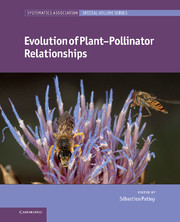Book contents
- Frontmatter
- Contents
- Contributors
- Preface
- 1 Macroevolution for plant reproductive biologists
- 2 Pollination crisis, plant sex systems, and predicting evolutionary trends in attractiveness
- 3 Evolution and ecological implications of “specialized” pollinator rewards
- 4 Fig–fig wasp mutualism: the fall of the strict cospeciation paradigm?
- 5 Fossil bees and their plant associates
- 6 Pollen evidence for the pollination biology of early flowering plants
- 7 Pollinator mediated floral divergence in the absence of pollinator shifts
- 8 Animal pollination and speciation in plants: general mechanisms and examples from the orchids
- 9 Why are floral signals complex? An outline of functional hypotheses
- 10 A survey on pollination modes in cacti and a potential key innovation
- 11 Zygomorphy, area, and the latitudinal biodiversity gradient in angiosperms
- 12 Ambophily and “super generalism” in Ceratonia siliqua (Fabaceae) pollination
- 13 Structure and dynamics of pollination networks: the past, present, and future
- 14 Pollinators as drivers of plant distribution and assemblage into communities
- 15 Effects of alien species on plant–pollinator interactions: how can native plants adapt to changing pollination regimes?
- 16 Pollen resources of non-Apis bees in southern Africa
- 17 Advances in the study of the evolution of plant–pollinator relationships
- Index
- Plate section
- References
11 - Zygomorphy, area, and the latitudinal biodiversity gradient in angiosperms
Published online by Cambridge University Press: 05 January 2012
- Frontmatter
- Contents
- Contributors
- Preface
- 1 Macroevolution for plant reproductive biologists
- 2 Pollination crisis, plant sex systems, and predicting evolutionary trends in attractiveness
- 3 Evolution and ecological implications of “specialized” pollinator rewards
- 4 Fig–fig wasp mutualism: the fall of the strict cospeciation paradigm?
- 5 Fossil bees and their plant associates
- 6 Pollen evidence for the pollination biology of early flowering plants
- 7 Pollinator mediated floral divergence in the absence of pollinator shifts
- 8 Animal pollination and speciation in plants: general mechanisms and examples from the orchids
- 9 Why are floral signals complex? An outline of functional hypotheses
- 10 A survey on pollination modes in cacti and a potential key innovation
- 11 Zygomorphy, area, and the latitudinal biodiversity gradient in angiosperms
- 12 Ambophily and “super generalism” in Ceratonia siliqua (Fabaceae) pollination
- 13 Structure and dynamics of pollination networks: the past, present, and future
- 14 Pollinators as drivers of plant distribution and assemblage into communities
- 15 Effects of alien species on plant–pollinator interactions: how can native plants adapt to changing pollination regimes?
- 16 Pollen resources of non-Apis bees in southern Africa
- 17 Advances in the study of the evolution of plant–pollinator relationships
- Index
- Plate section
- References
Summary
Introduction
In angiosperms, floral symmetry (Sargent 2004) is one of several traits, including mating system (Vamosi and Vamosi 2004), fruit type (Smith 2001), growth form (Verdú 2002), and distribution (Ricklefs and Renner 1994; Jansson and Davies 2008), that have been investigated in terms of their roles as key innovations leading to differential diversification rates in angiosperms. When a key innovation evolves, either through the evolution of a new structure or a transition from one state to another, it is thought that this will lead to what is known as phylogenetic tree imbalance (Fig 11.1). The existence and putative mode of action of key innovations have a long history in evolutionary biology (Farrell et al. 1991; Heard and Cox 2007). Darwin was initially reluctant to embrace the idea of key innovations because they did not adhere to the ideas of gradualism. Yet, the rapid diversification of flowering plants presented what he coined as an “abominable mystery” that could only be reconciled with theories of gradualism if one imagined that certain traits conferred higher levels of diversification. Whether any of the aforementioned traits presents a consistent overarching key to the abominable mystery has remained elusive (Davies et al. 2004a). Although previous studies have found associations between particular states of various traits and diversification, most of these have focused on individual traits and rather limited numbers of sister groups. Furthermore, geographical aspects of particular lineages have been relatively neglected, despite their inherent influences on speciation and extinction rates (Gaston 1998; Orme et al. 2006).
- Type
- Chapter
- Information
- Evolution of Plant-Pollinator Relationships , pp. 320 - 343Publisher: Cambridge University PressPrint publication year: 2011
References
- 1
- Cited by



